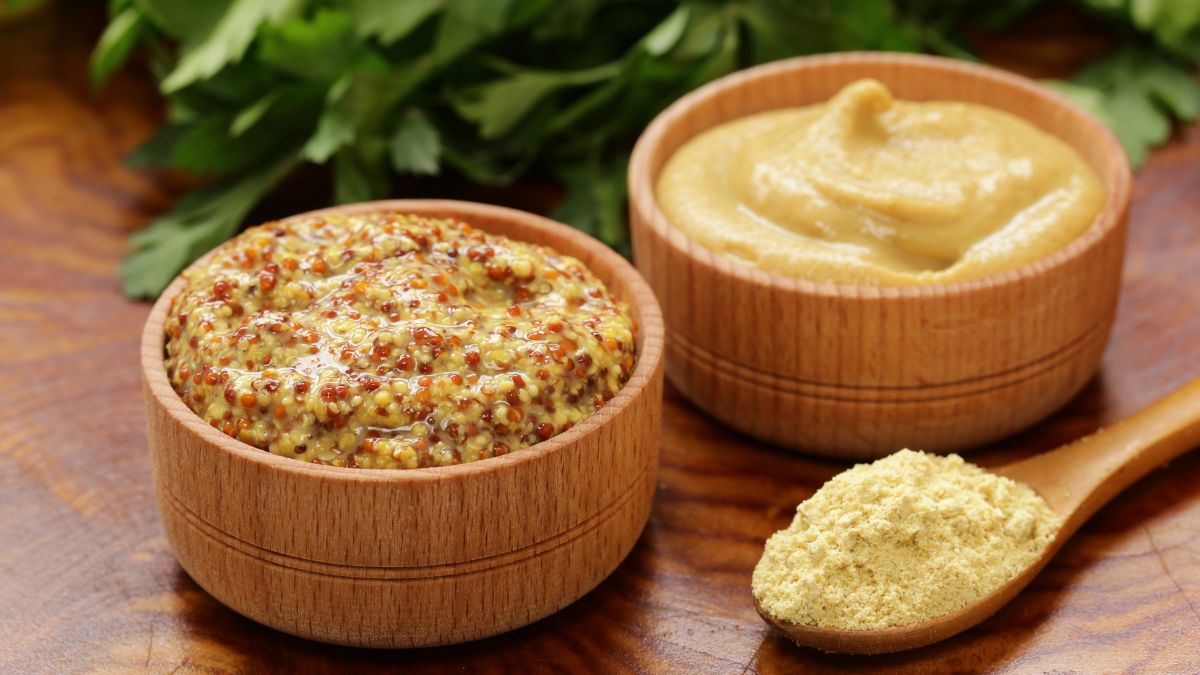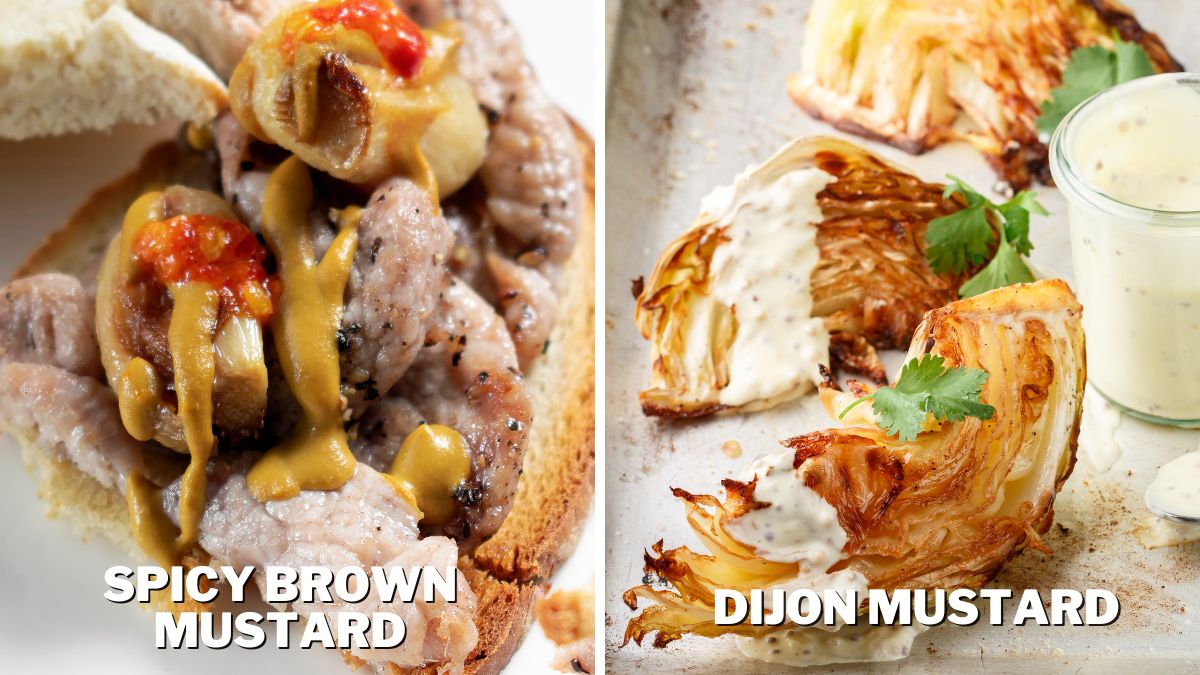Spicy Brown Mustard vs. Dijon: Differences & Uses

Mustard is probably the oldest condiment in the world, originating from ancient Rome. Nowadays, the two are popular everywhere because they can blend into numerous meals. I like using them because they make a flavorful addition to boring dishes to kick the flavor and texture, but also as star dips on deli and pretzel platters. Plus, you will have a more intense flavor as the pungency fades away standing on shelves. Let’s see what’s the difference and which one is better, spicy brown mustard or Dijon.
Silky smooth Dijon mustard is a combination of brown and yellow mustard seeds, while grainy spicy brown mustard contains solely brown seeds. While Dijon is wine-based, brown mustard is more piquant and has a richer spice blend. The former is the perfect deli condiment, and the latter is irreplaceable in salad dressings!
A good sauce will lift up the flavor of almost any meal, especially meat. I love to use mustard with chicken and beef as it keeps the cuts tender and juicy. Maybe it’s a crime, but I’m a sucker for dipping French fries into spicy brown mustard! ☺ Follow along to find out everything you have to know about these two versions of your favorite condiment!
Ingredients and Preparation
Ingredients for both mustard varieties are pretty much the same, but the ratio is where the difference lies. There are actually 3 types of mustard seeds: yellow, brown, and black, which have different levels of spiciness. Following that, yellow seeds are mild, while brown and black ones are hot and pungent.
When making Dijon mustard, first, you have to grind seeds until they reach a yellow color and paste-like texture. That will take about 10 minutes or so, and that’s the moment to add other ingredients. Mix up salt, sugar, white wine, and white vinegar, plus other spices if using.
The texture will still be coarse, so pass the Dijon mustard through a sieve once or twice till smooth. Here’s how to exactly make it at home — it only takes one hour and an instant pot!
Spicy brown mustard’s base ingredients are brown seeds and just a tad of vinegar, much less than in a regular mustard recipe. When it comes to choosing the right vinegar, go for any you have or like, from apple cider to white wine vinegar – only acidity is important. What makes this mustard stand out are additional spices, though.
Besides Kosher Sea salt and brown sugar, this is a spice range to choose from – cayenne pepper, allspice, nutmeg, turmeric, cinnamon, tarragon, ginger, paprika, or even honey. You’ll need brown mustard seeds for Dijon mustard, as well. But there are recipes with yellow or black seeds mixture to soothe or spice things up.
Being a French condiment, it’s more than expected for Dijon to contain white wine. Traditionally, the recipe calls for verjuice – juice from young, unripe grapes. This doesn’t mean that you don’t need vinegar, but here, choose white to blend perfectly.
Unlike brown spicy vinegar, it’s not strange to add fresh onion – yellow or shallots and garlic. You can skip that step, too, and hold on to classic Kosher salt and sugar – nothing else. For more spice, be free to add a pinch of white pepper.
The first step in preparing homemade mustard is soaking the seeds. You can soak them in water, vinegar, or a mix of those two. This is important to rehydrate dry seeds so the relish wakes up again.
Keep in mind to use a glass dish for soaking, never plastic, for the best results. Now, you can but don’t have to strain the seeds because bitterness is concentrated in the skins. If you fancy a very bitter aftertaste, skip to the next step. I like to strain them, though.
For a spicy brown mustard, blend together the soaked brown seeds and vinegar, along with the spices you choose. You can alter the flavor by adding more sugar if it’s too bitter or more vinegar if it’s too hot. Moreover, don’t mix it at the highest speed at all.
No matter which mustard variety you make, keep it in a glass jar refrigerated for about 3 days. That will help the flavors to blend and incorporate, plus it will lose the initial bitterness.
Taste, Texture, and Appearance
The taste of Dijon mustard is easiest to explain when compared to regular yellow mustard. The flavor profile is the same, but more mustardy, robust, tangy, and intensive. Spicy brown mustard is exactly what its name says, as the small doses of acid make it extra hot.
Considering that spicy brown mustard has a coarser texture, it is slightly more bitter than Dijon which is creamy smooth. Also, Dijon has a yellowish color, much paler than spicy brownish mustard with dark flakes. Brown mustard has a much richer spice blend in its recipe, which gives a base note of earthiness, warmth, and nuttiness.
Spiciness Level
Naturally, dried seeds aren’t spicy on their own since the liquid liberates the heat in question. Also, the liquid choice is super important, as acid actually soothes the hotness. That’s the reason why you need to add acidic components, plus you can add more or less to adjust the flavor.
When comparing spiciness levels, they are both hot to start with, but spicy brown mustard is more piquant. That’s because it contains solely pungent brown mustard seeds, while Dijon is usually a mixture of mild yellow and hot brown or black seeds. Here’s what the spicy brown one tastes like in more detail.
Uses
Spicy brown mustard is popular as deli mustard because it pairs impeccably with sapid tastes of smoky meat. It is perfect in sandwiches with pastrami, sausages, and especially German bratwurst. I’m a huge fan of soft Bavarian pretzels, and this mustard is a perfect dip for it.
Dijon mustard marries best with potato salads and mac and cheese. I like to use Dijon as a base for salad dressings, along with lemon, garlic, and fresh herbs. For example, chicken salad or coleslaw is top-notch with mustard.
One time at a family dinner, I tried roasted cabbage wedges with Dijon mustard sauce and never ate it differently again. Actually, any roasted or grilled vegetables are top-tier when coated in Dijon. If you’re a piquant food lover like me, you have to try rubbing the spicy brown mustard over any meat.
My favorite is lamb roast because it gets a wonderful glossy crust on top while keeping a succulent inside. For brunch, make a spicy sauce of brown mustard with some lemon to make a bed for poached eggs. Serve it with some toasted bread or sourdough for the best taste possible!

Varieties
I mentioned before that Dijon mustard can contain fresh garlic and onion. If you decide to use them, you’ll have to simmer them and save the liquid to use with seeds. Here, you can choose from shallots, yellow, or white onion, depending on what flavor you want to achieve.
The trick is to soak the mustard seeds in vegetables and vinegar broth until it thickens. What’s more, the next step is blending into a purée-like texture and simmering the mustard as a final touch. I find this unnecessary, to tell the truth, as it’s a more spicy prepared traditional way.
When speaking of spicy brown mustard, there’s not much to change except the texture and spice blend. If the grainy texture is not your cup of tea, be free to smooth it out by passing it through a sieve. Also, you can add some honey for a sweet note or turmeric for peppery and musky relish.
Substitutes
An ideal substitute for Dijon is yellow mustard, which is a tad milder and muskier because of turmeric. Also, stone-ground mustard is an extra stand-in because of its taste, but not the texture, though. There are whole mustard seeds left, so it’s not silky like Dijon, which I don’t mind at all.
Stone-ground mustard is also a good substitute for spicy brown. Here more for the texture, less for the taste. If you want something equally strong, consider a tad (only a tad!) of wasabi paste.
Are Spicy Brown Mustard and Dijon Interchangeable?
They are interchangeable, but not in every dish, though. They both pair well with deviled eggs, as well as with roasted or cooked potatoes. Likewise, you can use one or another with any meat and fish, considering how fiery you want it to be.
When using mustard in already spicy meals, the brown one is not a very good option, as it can come off too strong. In some spicy stews, it’s a surplus, same as in tender salads, because it will take over all of the flavors.
Here’s a handy table that summarizes everything we have talked about! Which one out of the two do you prefer? Tell me all about it below in the comments!
| Criteria | Dijon Mustard | Spicy Brown Mustard |
|---|---|---|
| Mustard seeds | brown, black, and yellow – usually mixed | brown |
| Acid | white wine or verjuice | vinegar – apple cider or white |
| Spices | salt, sugar, white pepper | salt, brown sugar, nutmeg, turmeric, allspice, paprika, cayenne pepper, ginger, tarragon, cinnamon |
| Taste | mustardy, robust, tangy | strong, earthy, bitter |
| Texture | silky smooth | coarse |
| Color | yellowish | brownish |
| Spiciness level | hot | hotter than Dijon |
| Meal pairing | salad dressings, mac and cheese, deviled eggs, roast | deli meat, sausages, soft pretzels, deviled eggs |
| Substitutes | yellow mustard, stone-ground mustard | stone-ground mustard, wasabi |
